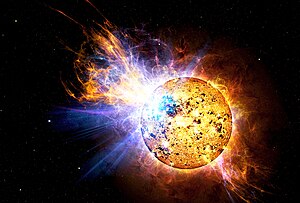EV Lacertae (EV Lac, Gliese 873, HIP 112460) is a faint red dwarf star 16.48 light-years away in the constellation Lacerta. It is the nearest star to the Sun in that region of the sky, although with an apparent magnitude of 10, it is only barely visible with binoculars. EV Lacertae is a spectral type M3.5 flare star that emits X-rays.[9]
| Observation data Epoch J2000 Equinox J2000 | |
|---|---|
| Constellation | Lacerta |
| Right ascension | 22h 46m 49.73126s[1] |
| Declination | +44° 20′ 02.3744″[1] |
| Apparent magnitude (V) | 10.26[2] |
| Characteristics | |
| Spectral type | M3.5[3] |
| U−B color index | +0.83[4] |
| B−V color index | +1.36[4] |
| Variable type | Flare star |
| Astrometry | |
| Radial velocity (Rv) | −0.23±0.17[1] km/s |
| Proper motion (μ) | RA: –706.216 mas/yr[1] Dec.: –458.920 mas/yr[1] |
| Parallax (π) | 197.9573 ± 0.0220 mas[1] |
| Distance | 16.476 ± 0.002 ly (5.0516 ± 0.0006 pc) |
| Details | |
| Mass | 0.32±0.008[5] M☉ |
| Radius | 0.331±0.013[5] R☉ |
| Temperature | 3370+75 −71[5] K |
| Metallicity [Fe/H] | –0.01 ± 0.17[6] dex |
| Rotation | 4.3715±0.0006 d[7] |
| Rotational velocity (v sin i) | 4.5[8] km/s |
| Other designations | |
| Database references | |
| SIMBAD | data |
Location of EV Lacertae in the constellation Lacerta | |

On 25 April 2008, NASA's Swift satellite picked up a record-setting flare from EV Lacertae.[11] This flare was thousands of times more powerful than the largest observed solar flare. Because EV Lacertae is much farther from Earth than the Sun, the flare did not appear as bright as a solar flare. The flare would have been visible to the naked eye if the star had been in an observable part of the night sky at the time. It was the brightest flare ever seen from a star other than the Sun.
EV Lacertae is much younger than that of the Sun. Its age is estimated at 300 million years, and it is still spinning rapidly. The fast spin, together with its convective interior, produces a magnetic field much more powerful than that of the Sun. This strong magnetic field is believed to play a role in the star's ability to produce such bright flares. After the flare, the star was blue.[12]
In October 2022, another stellar flare was observed in EV Lacertae by a group of scientists led by Shun Inoue of Kyoto University, after observing the star in near-ultraviolet and white-light curves.[13] The finding was announced and detailed in December 31, 2023, in the pre-print server arXiv.[13]
References
edit- ^ a b c d e Vallenari, A.; et al. (Gaia collaboration) (2023). "Gaia Data Release 3. Summary of the content and survey properties". Astronomy and Astrophysics. 674: A1. arXiv:2208.00211. Bibcode:2023A&A...674A...1G. doi:10.1051/0004-6361/202243940. S2CID 244398875. Gaia DR3 record for this source at VizieR.
- ^ a b "V* EV Lac -- Flare Star". SIMBAD. Centre de Données astronomiques de Strasbourg. Retrieved 2010-06-12.
- ^ Montes, D.; López-Santiago, J.; Gálvez, M. C.; Fernández-Figueroa, M. J.; De Castro, E.; Cornide, M. (November 2001). "Late-type members of young stellar kinematic groups - I. Single stars". Monthly Notices of the Royal Astronomical Society. 328 (1): 45–63. arXiv:astro-ph/0106537. Bibcode:2001MNRAS.328...45M. doi:10.1046/j.1365-8711.2001.04781.x. S2CID 55727428.
- ^ a b Erro, B. I. (1971). "Infrared photometry of UV CET stars". Boletin del Instituto de Tonantzintla. 6: 143. Bibcode:1971BITon...6..143E.
- ^ a b c Pineda, J. Sebastian; et al. (September 2021). "The M-dwarf Ultraviolet Spectroscopic Sample. I. Determining Stellar Parameters for Field Stars". The Astrophysical Journal. 918 (1): 23. arXiv:2106.07656. Bibcode:2021ApJ...918...40P. doi:10.3847/1538-4357/ac0aea. S2CID 235435757. 40.
- ^ Rojas-Ayala, Bárbara; et al. (April 2012). "Metallicity and Temperature Indicators in M Dwarf K-band Spectra: Testing New and Updated Calibrations with Observations of 133 Solar Neighborhood M Dwarfs" (PDF). The Astrophysical Journal. 748 (2): 93. arXiv:1112.4567. Bibcode:2012ApJ...748...93R. doi:10.1088/0004-637X/748/2/93. S2CID 41902340.
- ^ Morin, J.; Donati, J.-F.; et al. (October 2008). "Large-scale magnetic topologies of mid M dwarfs". Monthly Notices of the Royal Astronomical Society. 390 (2): 567–581. arXiv:0808.1423. Bibcode:2008MNRAS.390..567M. doi:10.1111/j.1365-2966.2008.13809.x. S2CID 11240756.
- ^ Phan-Bao, Ngoc; Martín, Eduardo L.; Donati, Jean-François; Lim, Jeremy (July 2006). "Magnetic Fields in M Dwarfs: Rapid Magnetic Field Variability in EV Lacertae". The Astrophysical Journal. 646 (1): L73–L76. arXiv:astro-ph/0603480. Bibcode:2006ApJ...646L..73P. doi:10.1086/506591. S2CID 18410819.
- ^ Schmitt JHMM; Fleming TA; Giampapa MS (Sep 1995). "The X-ray view of the low-mass stars in the solar neighborhood". Astrophys. J. 450 (9): 392–400. Bibcode:1995ApJ...450..392S. doi:10.1086/176149.
- ^ Abdul-Aziz, H.; Abranin, E. P.; Alekseev, I. Yu; Avgoloupis, S.; Bazelyan, L. L.; Beskin, G. M.; Brazhenko, A. I.; Chalenko, N. N.; Cutispoto, G.; Fuensalida, J. J.; Gershberg, R. E.; Kidger, M. R.; Leto, G.; Malkov, Yu. F.; Mavridis, L. N.; Pagano, I.; Panferova, I. P.; Rodono, M.; Seiradakis, J. H.; Sergeev, S. G.; Spencer, R. E.; Shakhovskaya, N. I.; Shakhovskoy, D. N. (December 1995). "Coordinated observations of the red dwarf flare star EV Lacertae in 1992". Astronomy and Astrophysics Supplement Series. 114: 509–526. Bibcode:1995A&AS..114..509A. Retrieved 14 January 2022.
- ^ Dunbar, Brian (May 20, 2008). Smith, Yvette (ed.). "Pipsqueak Star Unleashes Monster Flare". NASA. Retrieved 2010-06-12.
- ^ "- YouTube". YouTube.
- ^ a b Nowakowski, Tomasz; Phys.org. "New large stellar flare detected from EV Lacertae". phys.org. Retrieved 2024-01-11.

